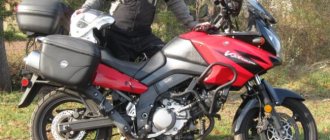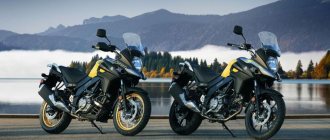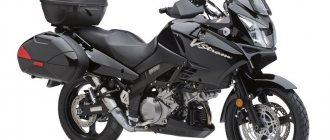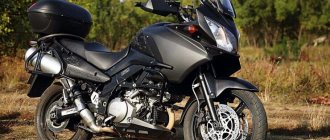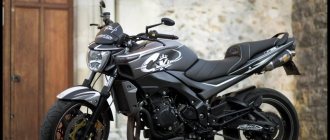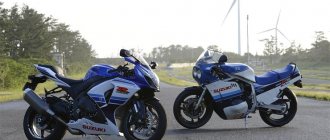Suzuki V-strom 650 xt 2018
When it comes to full-size touring enduros, you usually imagine a powerful bike that can intimidate some people before it's even lifted off the stand. Will I be able to handle his weight? What if he falls and I don’t pick him up? Can I handle its power? These questions are often found in people’s heads and on forums.
Medium tourenduros look much more attractive in this regard. They are quite large, but not menacingly huge; fast, but do not cause complexes among sportbike owners, and they are also cheaper to operate. The Suzuki V-Strom 650 XT is the newest entrant into this ever-expanding segment, and it's quite the player.
Design and ergonomics of the Suzuki V-Strom 650 XT
Based on the looks of its older brother, the Suzuki V-strom 1000, 650 XT looks like a slightly smaller version of it. This is purely a matter of taste, but personally, in my opinion, he looks extremely... how can I say... pragmatic, or something. Functional. Let's stick to "functional".
From its beak to its minimalist tail, the Suzuki V-Strom 650 XT looks ready to take on rougher terrain. At the same time, when it’s clean, it looks damn bright - for example, those gold rims that complement the canary yellow color of the big tank really “sell” it in that color. Well, unless of course the boring white tank and black rims seem more attractive to you.
Suzuki V-Strom 650 XT
The spoked wheels are shod with tubeless rubber, and it's a win-win combination. Spokes withstand road imperfections much better than alloy wheels, and tubeless tires are easy to repair in the field. There are larger and more expensive motorcycles on which it is still impossible to install tubeless tires on spoked wheels.
Suzuki has managed to maintain a balance of on-road and off-road ergonomics. The seating position is relatively low (835 mm), the footpegs are not too far back, and the handlebars are wide. So it's quite comfortable on the pavement, especially once you get used to the seat. Once off the asphalt, you will be pleasantly surprised that the shape of the large tank helps keep the bike in place with your knees, and the wide handlebar makes active steering between obstacles easier. The tank became narrower, but retained the same capacity - 20 liters.
Competitors
The first Japanese who comes to mind in the touring-enduro class is, of course, Yamaha with its Tenere.
Yamaha XTZ 660
The Yamaha XTZ 660 is a good choice for those who are interested in an inexpensive touring motorcycle.
XTZ 660 launched in 1991 , XT 660 Z - conceived as an update to the line, was released already in 2007 . Compared to Suzuki, they had 1-cylinder engines and a 5-speed gearbox. Because of this, they lost in terms of dynamics and maximum speed.
Honda XL700V Transalp
Honda was not far behind. Its XL700V Transalp was released in 2008.
The model was produced up to and including 2011, mainly for the European market.
It had a V-shaped engine with 2 cylinders , a 5-speed gearbox , a speed comparable to Suzuki, but at the same time it lost in dynamics . It’s interesting that the brand also has a 650cc model, but only the older model was offered for comparison.
Kawasaki Versys 650
Kawasaki Versys 650 is one of the leaders in all-purpose touring motorcycles.
Kawasaki came closest to Suzuki.
The 650cc Versys model also has 2 cylinders (in-line), 6-speed gearbox , chain drive , and comparable speed. But it differs in three stock configuration options. From minimal - protection of hands, tank, side cases to luxury , in which an additional case is installed in the back, fog lights with LEDs, a second 12 V .
Engine Suzuki V-Strom 650 XT
Suzuki V-Strom 650 XT is equipped with a two-cylinder 650 cc liquid-cooled engine. The engine has excellent manners, delivering excellent thrust at low and mid-range speeds, making driving in the city comfortable without the need to constantly click through gears. You can even sneak around 40 km/h in sixth without making the engine protest, and the smooth opening of the throttle when overtaking makes the bike fire without any visible strain. This is exactly the type of traction that is needed for carefree driving in city traffic. And for added convenience at low speeds, Low RPM Assist technology prevents engine stalling by automatically increasing speed in situations where the engine is at risk of stalling: when operating the clutch, or when driving at low speeds in traffic jams. An interesting feature of the Suzuki V-Strom 650 XT motorcycle is the Easy Start system, which allows you to start the engine with one short press of the starter button, automatically turning off the starter after the engine starts.
Suzuki V-Strom 650 XT
The engine is very responsive both at low and high speeds. Traction increases linearly, and the motorcycle reaches 100 km/h in 5.1 seconds, which is quite good by tourenduro standards. A smooth set of traction is no less important and convenient when off-road riding, allowing the rider to accurately dose it. And smart two-stage traction control will help out if the hand trembles and the rider lets down. The system works equally well both on the hard and wet pavements of European cities and on rain-washed rural paths. Traction control constantly monitors the speed of both wheels, the position of the throttle, and also monitors the position of the crankshaft and the number of the selected gear, and controls engine traction, shifting the ignition timing and the amount of air supplied. The two traction control modes are sensitive: the first allows wheel slip for a more advanced steering technique, while the second traction control detects the slightest deviation in rear wheel speed, giving complete confidence when driving on slippery surfaces or in the rain. Modes are switched on the left console and displayed on the instrument panel, and of course there is the option to turn off the traction control completely, a must for experienced off-road riders.
In addition to the engine's torque, it should be praised for its completely carefree nature at cruising speed. At 100 km/h, the tachometer needle reaches 4500 rpm, which means you can comfortably drive at 120-140 km/h. The quiet nature of the engine helps save fuel, and consumption in the city is around 4 l/100 km, and on the highway it reaches 3.3 l/100.
Suzuki V-Strom 650 XT
The engine complies with Euro4 emissions standards, and in the process of adapting to the tight confines of emission standards, the engine has been modified on many fronts. It received polymer-coated pistons and revisions to more than 60 other components. The polymer coating reduces friction, increasing efficiency and improving the environmental friendliness of the exhaust. Special L-rings provide improved sealing and reduce the amount of gases allowed into the crankcase. And Dual Spark technology, unique in this class (two spark plugs per cylinder), ensures the most accurate ignition. Combined with new nickel spark plugs, this technology provides improved combustion efficiency, smoother traction and reduced fuel consumption and emissions.
Peculiarities
Among the features of the motorcycle are:
- adjustable suspension (if competitors took length, then Suzuki used adjustments);
Front fork – adjustable spring preload.
Rear shock absorber – adjustable preload and rebound damping.
- aluminum frame (of course less weight, but strength? Competitors have it made of steel);
- separating into separate modifications parts offered by competitors in stock.
- 71 horsepower (in latest developments)
Some users also call weight. But for the above competitors it is either comparable or even less.
Handling Suzuki V-Strom 650 XT
The Suzuki V-Strom 650 XT is based on a twin-spar aluminum frame with a conventional fork and a monoshock absorber with adjustable spring preload. Small irregularities are absorbed by the pendant with prim elegance: oh, really, this is such a trifle...
In turns, it is obviously not as precise and sharp as a supersport, but it is far from an oil barge in terms of maneuverability. It feels stable, predictable and reliable, inspiring confidence through a series of corners. Bridgestone Battlax Adventure rubber is a dual-purpose tire that provides excellent feedback on both pavement and off-road. The longer wheelbase (1560 mm) also improves ride stability, and overall the Suzuki V-Strom 650 XT handles quite well for its size. And in addition to good on-road dynamics and a gentle character, it has serious off-road capabilities and bad roads thanks to spoked wheels shod with tubeless tires.
Suzuki V-Strom 650 XT
Weight
In 2011-12, the motorcycle received a major update, which affected both the filling and external parameters.
Curb weight changed from 207 to 214 kg .
Dry from 185 kg to 195 kg .
Motorcycles without stock ABS weighed ~20 kg less.
Dimensions
Currently, the model is one of the lightest among motorcycles of this class.
The sizes have changed several times:
- The length of the bike has become shorter - from 2290 mm to 2275 mm ;
- lost weight in width - from 840 mm to 835 mm ;
- grew in height - from 1390 mm to 1405 mm .
The wheelbase has also become larger - from 1540 mm to 1560 mm .
Seat height - from 820 mm to 835 mm .
Ground clearance - from 165 mm to 175 mm .
For whom is it intended?
One statement from the developers that this is an export version indicates that the biker cannot be short.
The optimal height for the owner of this motorcycle is from average and above.
However, even tall users ( above 180 cm ) note that the motorcycle is tall. “I stand on tiptoes at traffic lights.”
Advantages
Users note:
- Convenience.
- Large windshield. Reliable protection from wind and rain at any speed from 100 to 180.
Despite the impressive size of the windshield, tall owners install an additional deflector so that the air flow passes over the helmet.
- Reliability.
- Affordable price (for some reason it is compared with the German “geese”, BMW R 750GS, BMW F 750GS).
- Accessories . Being essentially a hybrid between the liter DL 1000 and the naked SV 650 , it can use repair kits from both.
Sometimes they add design, ABS, good tires and long suspension travel.
Flaws
To make the bike even better, it's worth installing the optional crankcase guard, otherwise the open engine will quickly turn into a lump of dirt.
- Users do not note any significant disadvantages except for one thing – love for butter . 0.5 liters per 1,000 km are noted . Some owners say that they need to fill in 10w/50 or 15w/50 instead of the standard 10w40 or less.
- They write about the falsity of moving at low speeds - but this depends more on the driver, and not on the motorcycle.
- Vibrations . Despite the 2 cylinders, they are there. They don’t interfere with movement, nothing is transferred to the handles/mirrors/pegs, but the bolts need to be tightened periodically.
Some people note the weight, but for a good off-road bike this is more a plus than a minus

